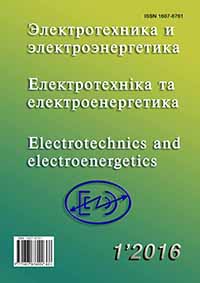OPTIMAL AND QAUSI-ENERGY-SAVING CONTROL POSATION VARIABLE FREQUENCY ASYNCHRONOUS MOTORS
DOI:
https://doi.org/10.15588/1607-6761-2016-1-4Keywords:
asynchronous motor, frequency regulation, an optimal position controlAbstract
The article is devoted to developing and researching the best energy-saving control position FCIM with small movements with the help of which would be provided to minimize the total electromagnetic energy losses in the engine when this positioning mode.Using the method of the calculus of variations to offer optimal and quasi-optimal types of energy-saving variable frequency control the position of the induction motor (FCIM), which provide basic minimization of electromagnetic energy loss (BEEL) of the engine when developing an arbitrary value of a small displacement of the shaft in the required time. Obtained for the proposed types of energy-saving control analytical dependencies to change the position and speed of the time, as well as to determine the maximum value of the engine speed. Calculations of the time change process: position, speed, electromagnetic torque, modulus of the generalized vector of the stator current, general electromagnetic power loss and engine BEEL – relevant proposals and quasi optimal energy-saving type of control. A comparison between a proposed and known (parabolic and linear dependence of the velocity on the time change) types of energy-saving position control with small movements FCIM. Proposed optimal and quasi-optimal types of energy-saving position control are recommended for use in positional variable frequency asynchronous electric drive (for example, lifting-transport mechanisms and rotary platforms, urban and railway electric transport, etc..).
References
Булгаков А. А. Частотное управление асинхронными электродвигателями / А. А. Булгаков. – М. : Наука, 1966. – 298 с.
Костенко М. П. Электрические машины : Специальная часть / М. П. Костенко. – Л. : Госэнергоиздат, 1949. – 708 с.
Поляков В. Н. Экстремальное управление электрическими двигателями / В. Н. Поляков, Р. Т. Шрейнер. – Екатерибург : УГТУ – УПИ, 2006. – 420с.
Сандлер А. С. Автоматическое частотное управление асинхронным двигателем / А. С. Сандлер, Р. С. Сарбатов. – М. :Энергия, 1974. – 328 с.
Шрейнер Р. Т. Оптимальное частотное управление асинхронными электроприводами / Р. Т. Шрейнер, Ю. А. Дмитренко. – Кишинев : Штиинца, 1982. – 224 с.
Толочко О. И. Управление процессами намагничивания и размагничивания асинхронного двигателя в системах векторного управления / О. И. Толочко, П. И. Розкаряка, Г. С. Чекавский, А. К. Кушель // Електромеханічні і енергозберігаючі системи. Щоквартальний науково-видавничий журнал. – Кременчук : КрНУ, 2011. – Вип. 3/2011(15). – С. 79–82.
Волков В. А. Оптимизация режимов намагничивания и размагничивания частотно-регулируемого асинхронного двигателя / В. А. Волков // Наукові праці Донецького національного технічного університету. Сер. Електромеханіка і енергетика. –Донецьк : ДНТУ. –2013. – Вип. 2(15). – С. 64–69.
Волков А. В. Энергосберегающее управление скоростью частотно-регулируемого асинхронного двигателя в пускотормозных режимах / А. В. Волков, А. А. Колесников // Электротехника. – 2013. – № 5. – С. 2–9.
Волков В. А. Расчет оптимальных тахограмм разгона и торможения частотно-регулируемого асинхронного двигателя / В. А. Волков // Електротехніка та електроенергетика. – 2015. – № 2. – С. 55–64.
Петров Ю. П. Оптимальное управление электроприводом / Ю. П. Петров. – М.–Л.: Госэнергоиздат, 1961. – 187 с.
Петров Ю. П. Оптимальное управление электрическим приводом с учетом ограничений по нагреву / Ю. П. Петров. – Л.: Энергия, 1971. – 144 с.
Башарин А. В. Управление электроприводами / А. В. Башарин, В. А. Новиков, Г. Г. Соколовский. – Л.: Энергоиздат, 1992. – 392 с.
Андреева Е. А. Вариационное исчисление и методы оптимизации / Е. А. Андреев, В. М. Цирулева. – М. : Высш.шк., 2006. – 584 с.
Тиховод С. М. Усовершенствование итерационных методов решения систем нелинейных уравнений состояния магнитоэлектрических схем замещения / С. М. Тиховод // Електротехніка та електроенергетика. – 2015. – № 1. – С. 46–49.
Downloads
How to Cite
Issue
Section
License
Copyright (c) 2017 V.A. Volkov

This work is licensed under a Creative Commons Attribution 4.0 International License.
Creative Commons Licensing Notifications in the Copyright Notices
Authors who publish with this journal agree to the following terms:
Authors retain copyright and grant the journal right of first publication with the work simultaneously licensed under aCreative Commons Attribution License that allows others to share the work with an acknowledgement of the work's authorship and initial publication in this journal.
Authors are able to enter into separate, additional contractual arrangements for the non-exclusive distribution of the journal's published version of the work (e.g., post it to an institutional repository or publish it in a book), with an acknowledgement of its initial publication in this journal.
Authors are permitted and encouraged to post their work online (e.g., in institutional repositories or on their website) prior to and during the submission process, as it can lead to productive exchanges, as well as earlier and greater citation of published work.

